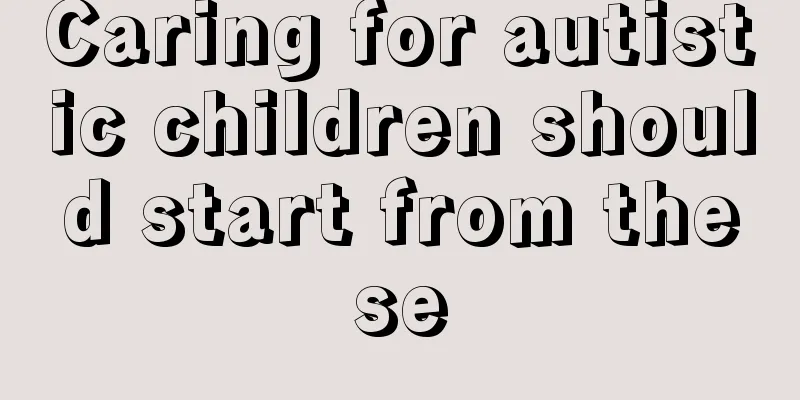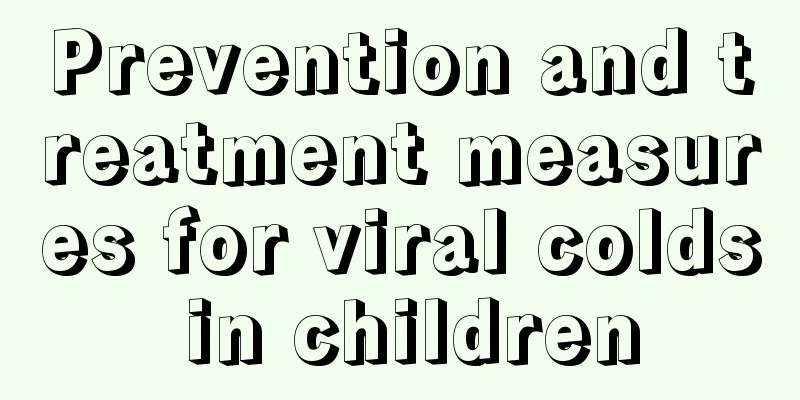What should I do if my child has tracheal inflammation?

|
Bronchitis is a very common disease when babies are young. Most bronchitis occurs due to respiratory tract infections. If a baby suffers from bronchitis, parents must treat it in time. Tracheitis is generally divided into acute bronchitis and chronic bronchitis. Most babies suffer from acute bronchitis. It is very important for babies to receive timely and effective treatment after suffering from bronchitis.
Bronchitis is very common in children, mostly secondary to upper respiratory tract infection. At the beginning of the disease, there are symptoms of upper respiratory tract infection, such as nasal congestion and runny nose, followed by intermittent dry cough. At the beginning of the disease, respiratory secretions increase, and the cough is accompanied by phlegm. The phlegm is initially sticky and quickly turns into purulent phlegm. After 5-10 days, the phlegm becomes thinner and the cough gradually disappears. When the disease occurs, there may be no fever or a fever of around 38.5℃, and the fever will subside after 2-4 days. In infancy, there is a special type of bronchitis called asthmatic bronchitis, which is more common in obese children under 2 years old, who often have a history of eczema and allergies. Asthma symptoms appear soon after onset and may recur. Generally, the symptoms disappear by the time the child reaches school age. Only a few develop bronchial asthma when they are older. The cause of the disease may be that the child is allergic to the infection, which manifests as bronchial spasm and causes wheezing. 1. Traditional Chinese Medicine Treatment (1) Decoction 1. Wind-cold cough type: The cough is heavy and urgent, with clear white sputum, nasal congestion and runny nose, aversion to cold without sweating, itchy throat, fever or no fever, headache, thin white tongue coating, and floating pulse. Use 6 grams each of almond, pinellia, and schizonepeta, 10 grams each of peucedanum and perilla leaves, 3 grams of ephedra, and 3 slices of ginger. Decoction in water, twice a day, 1 dose per day. 2. Wind-heat cough type: coughing up phlegm, which is yellow, thick and sticky, thirst, sore throat, runny nose, fever, headache, sweating, slightly yellow tongue coating, and floating and rapid pulse. Use 10 grams each of mulberry leaves, chrysanthemums, forsythia, loquat leaves, and 6 grams each of almonds, peucedanum, platycodon, and scutellaria. Decoction in water, take 1 dose daily, divided into 2 doses. 3. Heat and phlegm blocking the lungs: coughing with lots of phlegm that is thick and difficult to cough up, fever, red face, red eyes and lips, irritability, yellow and scanty urine, dry stool, yellow tongue coating, and slippery and rapid pulse. Use 3 grams of ephedra, 15-20 grams of gypsum, 6 grams each of apricot kernel, scutellaria, peucedanum, and perilla seed, 10 grams each of Fritillaria cirrhosa and Cucurbitacin seed, and 5 grams of radish. Decoction in water, 1 dose per day, divided into 2 doses; 2 doses per day can be taken if necessary. 4. Phlegm and cough type: cough, with a lot of white and sticky phlegm that is easy to cough up, chest and abdominal distension, loss of appetite, white and greasy tongue coating, and slippery or soft pulse. Use 10 grams each of Pinellia, Tangerine Peel, Apricot Kernel, Atractylodes Macrocephala, Poria, and Psoralea Corylifolia, 6 grams of Perilla frutescens, 1.5 grams each of White Mustard Seed and Asarum, 3 slices of ginger, and 3 dates. Decoction in water, take 1 dose daily, divided into 2 doses. 5. Yin deficiency and dry cough type: prolonged cough, dry cough with no or little sputum, thirst and dry throat, or hot flashes and night sweats, hot hands and feet, slightly red tongue, little or no coating, and a thin and rapid pulse. Use 10 grams each of Stemona bulbs, Adenophora stellaria, Anemarrhena asphodeloides, Apricot kernel, loquat leaf, Peucedanum chinense, 6 grams each of Aster tataricum and Prunus mume, and 3 grams of Indigo naturalis. Decoction in water, take 1 dose daily, divided into 2 doses. (2) Chinese patent medicine 1. Take Sangju Cold Tablets or Yinqiao Detoxification Tablets, 2 times a day, 3 tablets each time. For children under one year old, reduce the dosage accordingly. 2. Chuanbei loquat syrup, twice a day, 5 ml each time. Or use Yangyin Qingfei Paste, twice a day, 5-10 ml each time. For children under one year old, the dosage can be reduced accordingly. 3. Yinhuang oral liquid, 2-3 times a day, 5 ml each time.
1. Cough: compound licorice mixture, 1 ml each time for each year, 3 times a day. Severe cough: Take Kebiqing for patients over 5 years old, 6.25-12.5 mg each time. 2. Difficulty in coughing up phlegm: Take ammonium chloride 20-60 mg per kilogram per day, orally in 4 doses. 3. Persistent high fever: Sulfamethoxazole dry syrup, 1/2 packet once for children aged 2-5 years, 1-2 packets once for children aged 6-12 years, orally 3 times a day. Or acetylspiramycin tablets, 20-30 mg per kilogram of body weight per day, orally in 4 divided doses. Cough remedies 1. Radish and scallion white can treat cold and cough 1 radish, 6 green onions, 15 grams of ginger. Use three bowls of water to boil the radish first, then add the scallion and ginger, and cook until one bowl of soup remains. Take all the medicine including the residue at one time. It can clear the lungs and relieve exterior symptoms, resolve phlegm and relieve cough. Treats wind-cold cough, foamy sputum, chills, fatigue and body aches, etc. 2. Brown sugar, ginger and jujube soup for treating colds and coughs: 30 grams of brown sugar, 15 grams of fresh ginger and 30 grams of red dates. Boil with three bowls of water until half done. Take it immediately, and you will recover after you start sweating slightly. Dispel wind and cold. It is used to treat colds and coughs, stomach pain caused by cold, diarrhea caused by postpartum cold, and aversion to the yin, etc.
bell. Take it all at once while hot, and avoid wind and cold. Induce sweating to the surface. Treat cough caused by colds. 4. White radish and honey treat cold and cough. 1 large white radish, 30 grams of honey, 5 white peppercorns, and 2 grams of ephedra. Wash the radish, slice it, put it in a bowl, pour in honey, white pepper, ephedra, etc., steam it for half an hour, and drink it while it is hot. You will recover when you sweat in bed. Induces sweat and dispels cold, relieves cough and reduces phlegm. Treat cold and cough. 5. Sheep honey paste is used to treat cough, pulmonary tuberculosis and consumptive disease. It includes 250 grams of cooked sheep fat, 250 grams of cooked sheep marrow, 250 grams of white sand honey, 100 milliliters of ginger juice and 500 milliliters of raw Rehmannia juice. Fry the mutton fat until it boils; then add the mutton marrow and bring it to a boil again; then add the honey, Rehmannia root and ginger juice, stirring constantly, and simmer over low heat for several boils until it becomes a paste. Take 1 spoonful of this medicine with warm wine on an empty stomach every day, or make it into ginger soup or porridge. Nourish the lungs, eliminate wind and detoxify. It can treat yin deficiency fever, bone steaming and fatigue fever, consumptive emaciation, cough and lung atrophy, and also has the effect of moistening the lungs and skin. |
<<: What are the clinical manifestations of craniosynostosis?
>>: What should I do if my child has athlete's foot?
Recommend
Is 37.5 degrees Celsius considered a fever for a child?
What parents worry about most is their children h...
What is going on when my child has white spots on his fingers?
White spots on children's fingers may be caus...
What can’t a 1-year-old baby eat? These foods must be avoided
For a one-year-old baby, the digestive system is ...
Why does a 40-day-old baby have frequent bowel movements?
In China, some newborns have increased frequency ...
Do newborns sweat?
When a newborn is just born, there are many pheno...
How to use medicine for children’s vulvar itching?
When we were young, few parents could truly care ...
Why do children have bad breath?
We always think that bad breath is something that...
How long does a newborn usually suck milk?
After a newborn is born, most mothers will choose...
What to do if the baby doesn't want to eat complementary food?
There are many babies who are very picky when the...
When should babies take vitamin D?
In fact, many trace elements in the human body ar...
How long does it take for a baby to shed its skin?
Everyone should know that snakes have to shed the...
What should I do if my child has a birthmark on his face?
In short, birthmarks are the marks that babies br...
What is the cause of the small bumps on the back of children’s hands?
Children's bodies are more prone to problems ...
What are some ways to make your child grow taller quickly?
In daily life, we often see many children going t...
Children's nutritious meal recipes
Children's nutrition has always been a focus ...









